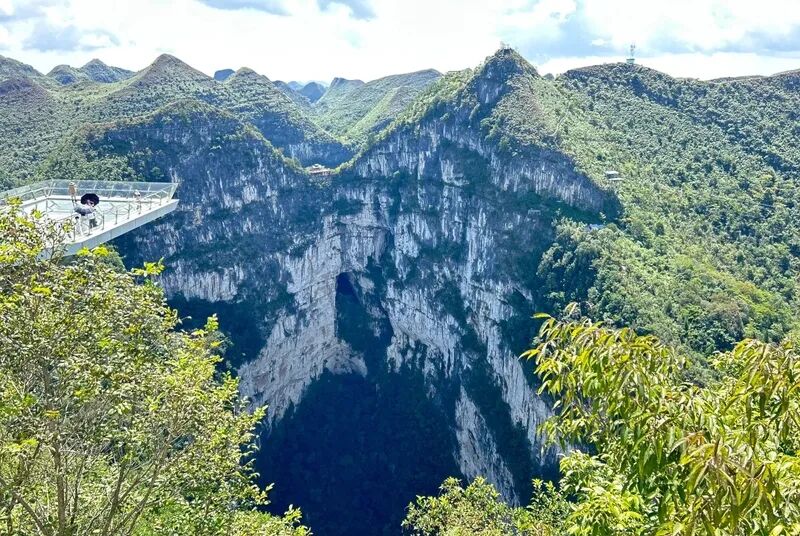China Cave Exploration Discovering Subterranean Wonders and Geological Marvels
China has dramatic landscapes. Under them lies another world. It’s a place of huge chambers, complex cave systems, and geological formations. These formations tell stories that took millions of years to make. Do you want adventure beyond normal sightseeing? China’s karst regions have some of the world’s most amazing underground adventures. Think of cave halls like cathedrals. Think of mysterious sinkholes that hide whole ecosystems. These places change what it means to explore.
Zhijin Cave, Guizhou: The Underground Palace

Guizhou has mountainous land. Zhijin Cave (also called Zhijin Dong) is there. It’s a breathtaking first look at China’s underground wonders. The cave stretches over 6 kilometers. Its chambers are up to 150 meters high. This huge cave system feels more like an underground cathedral than just a geological formation.
What makes Zhijin Cave special isn’t just its size. It’s the different kinds of formations inside. You can follow well-kept paths. Along the way, you’ll see tall stalagmites. They look like old trees. You’ll see delicate helicities that twist in impossible ways. You’ll see stone waterfalls that look frozen in time. The careful lighting makes the place feel strange and wonderful. It casts dramatic shadows. These shadows make the rock formations seem alive.
The cave stays at a steady temperature. It’s around 10-16°C (50-61°F) all year. So you can explore comfortably no matter the weather outside. Local guides work here. Many are from nearby Miao ethnic villages. They share more than just geological facts. They tell folk tales about how the cave formed. This mixes science with cultural tradition.
Wulong Karst, Chongqing: Beyond the Giant Sinkhole

The Wulong Karst National Geology Park offers perhaps China’s most dramatic example of karst topography. Here, the landscape doesn’t just feature caves—it’s defined by them. Three Natural Bridges, actually a series of massive limestone arches, form the park’s centerpiece, but the true adventure lies in exploring the interconnected cave systems beneath.
The most amazing feature is Tiankeng (Heavenly Pit). It’s a huge sinkhole. It’s 537 meters long and 300 meters wide. Going down into this natural hollow feels like entering another world. Plants cover the floor. A mysterious waterfall pours down one wall. It creates small climates that support unique plant species.
Movie fans might know parts of Wulong. It was a location for Transformers: Age of Extinction. This adds a fun, movie-like feel to the geological wonder. The park has good facilities. They let you explore easily. But they still keep the natural beauty of the formations.
Leye Tiankeng Cluster, Guangxi: Sinkhole Exploration Frontier

Guangxi has remote mountains. Leye Tiankeng Geopark is there. It has the world’s biggest group of sinkholes. Many people say it’s the best cave exploration spot in China. It’s not just one cave destination. This area has dozens of sinkholes in different sizes. Some have primitive forests. These forests have plants you can’t find anywhere else on Earth.
The adventure here is more rough and real. You’ll hike through thick plants to reach the edges of sinkholes. Then you’ll go down into the deep parts. Sunlight filters through openings. It lights up underground rivers and rare plants. The most famous sinkhole is Dashiwei Tiankeng. It’s 600 meters wide. It drops 420 meters straight down. Even experienced adventurers feel small when they see it.
Local Zhuang and Yao people have lived near these geological wonders for generations. They know the land well. That knowledge is very useful. Many work as guides. They share stories. They talk about how these “heavenly pits” are part of their culture and creation myths.
Why Cave Exploration Matters
Beyond the adrenaline rush and photographic opportunities, China’s cave systems offer profound lessons in patience—the slow, persistent work of water and time that creates these magnificent formations. As one geologist guiding our tours often remarks, “When you’re standing in a cave, you’re witnessing a conversation between rock and water that began before humans walked the earth.”
Practical Information for Your Adventure
Best Time to Visit: Autumn (September-November) has the most stable weather for all three places. Temperatures are mild. Rainfall is low. This makes cave exploration more comfortable.
Physical Requirements: Zhijin Cave has paved paths. Most fitness levels can handle it. But Wulong and Leye have lots of stairs. The ground there is uneven. You need to be in good physical shape to have the full experience.
Essential Gear:
• Sturdy hiking shoes with good grip
• Light jacket (caves stay cool all year)
• Good headlamp (for seeing better in dark areas)
• Waterproof camera or phone case
Sustainable Exploration: We work with local guides. They use and teach responsible caving methods. This makes sure we don’t harm these fragile ecosystems. Your visits help support conservation work and local communities.
A Journey Through Time
China’s cave systems are more than just adventure spots. They give you a new way to see things. In these underground worlds, your worries feel small for a while. That’s because geological time is so long. The formations you’ll see grew just a few centimeters every thousand years. This reminds you of how patiently nature creates beauty.
One recent visitor from Colorado said: “I came to take adventure photos. But I left with something more valuable. I felt wonder again—wonder at the hidden beauty of our planet.”
Ready to explore China’s amazing underground landscapes? Contact our adventure travel specialists. They’ll design a personalized caving trip for you. It will mix geological wonders with cultural insights. You’ll have an unforgettable journey beneath the surface.

Leave a Reply